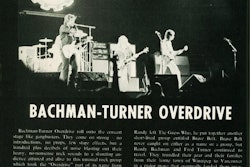Tips for Pre-trips
Checking out your rig before you hit the road is a DOT requirement and could make the difference between smooth sailing and a costly breakdown
“The pre-trip inspection is the beginning of my job,” says Gina Angsten, an owner-operator leased to Duplainville Transport. “It’s the base of keeping me safe. It’s my responsibility whether it’s a company trailer I’m pulling or not. It’s important I inspect not only my truck but my trailer.”
An oil spot on the ground is a telltale sign that something might be amiss while inspecting your truck.While the pre-trip inspection is a DOT requirement, Angsten says it’s something about which “drivers tend to get lax from time to time, particularly if they drive the same truck every day. Many drivers get really comfortable going off of what they hear [on the road] rather than what they see.”
But consistently conducting pre-trips, and practicing preventive maintenance, can help you avoid all manner of problems on the road, from roadside inspections to high-dollar breakdowns. While Angsten takes a solid 20 minutes on pre-trips, Dick McCorkle, an owner-operator leased to Perkins Specialized, says he’s been following the same 10-minute inspection routine for 25 years. It begins with looking for oil, water and radiator leaks on the ground.
Heyl Truck Lines driver Mark Padgett estimates he spends 30 minutes on pre-trips daily. He follows the same sequence each time to ensure he doesn’t forget something.
Mark Padgett makes sure he crawls under his trailer to check connections as part of his pre-trip.For Paccar General Marketing Manager Jeff Sass, the rule of thumb is “lights and leaks. Any type of lighting and seals are the big things often found. The third thing is tire condition — tread wear or inflation level.”
Angsten’s ritual begins with the hood open at the driver’s side steer tire and follows a counterclockwise path around the truck and trailer. She checks components under the hood, including belts, hoses and fluid levels. She uses a gauge to check each tire’s air pressure. McCorkle, on the other hand, uses the thump method to determine if all his tires are properly inflated. He also makes sure the spare is inflated and secured and that all the tires have valve stem caps to keep out dirt.
Gina Angsten carries bulbs for every type of light on her tractor and trailer in case she needs to replace one.Angsten does her inspections with the vehicle lights on to make sure all lights and four-ways are clear and working, including brake lights. She’ll pump down the air brakes and watch the pressure go down, then let the pressure build back up.
McCorkle checks the trailer’s back door, sealing it if the trailer’s empty or checking load security and sealing it again if it’s loaded.
Both operators check mirrors, horn, windshield wipers and washer fluid in the reservoir. They start their trucks to make sure dash gauges are functioning. Monthly, McCorkle checks battery cables. Padgett makes a point of ducking under his trailer to ensure all connections are intact and in good condition.
For repairs on the road, McCorkle carries fuel filters, a drive belt and a headlight. Angsten packs a replacement for the four different types of lights on her truck and trailer, and Padgett carries light bulbs and fuel filters.
One of first things Dick McCorkle does in his truck pre-trip inspection is look for fluid leaks on the ground.Truckers know that even the most complete pre-trip won’t prevent every breakdown, but it will head off most mechanical problems that can lead to costly roadside episodes. The Federal Motor Carrier Safety Administration’s Compliance, Safety, Accountability (CSA) program provides further incentive for consistent pre-trips.
“I do believe with the advent of CSA, every driver is going to be much more careful in their pre-trips and more stringent when they find any possible thing about not going on the road,” Sass says.
Angsten says if the thought of getting up early in the morning and doing a pre-trip seems daunting, taking care of part of the task the night before or when you shut down for the day can save time. “Nothing’s going to happen to your truck when it’s standing still,” she says. “In the summertime at night when I park my truck, I clean all my windows and mirrors so they’re ready to go in the morning.”
Padgett, who’s been driving for almost 30 years, says he’s taken pre-trip inspections more seriously in the last several years. “If it’s not safe, I don’t move,” he says.
INSPECTION PROTOCOL
The Oregon Trucking Association sees pre-trip inspections as more than checking out the working condition of your tractor and trailer. They are part of the driver’s job and will help prevent accidents.
Here are steps to take as part of your pre-trip, according to the OTA:
• Inspect yourself. Are you well rested? Fatigue or illness can drastically affect your ability to concentrate on driving. Are you wearing proper clothing for the weather conditions?
• Note your vehicle’s general condition. Look for fluid leakage on the ground and body damage. Walk around your vehicle to see any hazards such as debris, overhanging lines, tree limbs and other nearby vehicles.
• Check the engine compartment. Your company may require this in your pre-trip.
• Start the engine and check the gauges. Try out the steering wheel, clutch, brake pedal, parking brake, windshield wipers and horn. Make sure the inside of the windshield is free of film or haze caused by smoking or cold air. Check for fire extinguisher, reflective triangles and spare fuses.
• Do your walkaround. Carry a rag with you to wipe off lights. Make sure your turn signals are working. Check that your mud flaps are attached and in good condition. Check wheels for lug-nut tightness and cracks or rust marks. Inspect fuel tanks for leaks and proper mounting of the crossover line. Check the condition of the landing gear and crank. Inspect suspension system for broken or loose leaf springs, defective air bags or U-bolts. Check the condition of trailer frame and crossmembers and for missing bolts and bent or missing parts.
EQUIPMENT CHECKLIST
According to the U.S. Department of Transportation, pre-trip vehicle inspections must cover:
• Coupling devices
• Emergency equipment
• Horn
• Lighting devices and reflectors
• Parking brake
• Rear-vision mirrors
• Service brakes, including trailer brake connections
• Steering mechanism
• Tires
• Wheels and rims
• Windshield wipers
ONLINE EXTRA
For more information on pre-trip inspections go to the FMCSA website at www.fmcsa.dot.gov, click on “Rules & Regulations, then under “Federal Regulations” click on “Vehicle-related Regulations” and look for “Inspection, repair and maintenance.”









